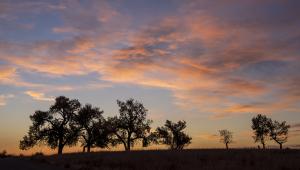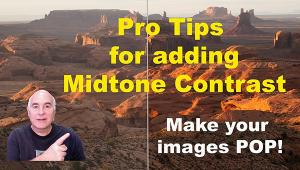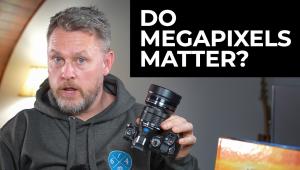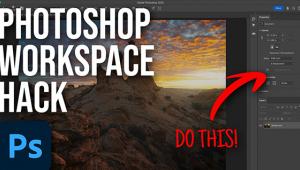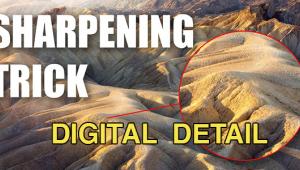Several years ago MS announced a new compression format that was supposed to replace JPG - better compression with fewer or no artifacts. It seems to have disappeared. Any idea what happened?
Ask A Pro: Scott Kelby Answers Your Photography Questions

Got Questions About Photography? Professional Photographer and Photoshop Expert Scott Kelby Has Got Answers.
Q. I can’t seem to get exposure compensation to work on my camera. I shoot in Manual mode on a Canon EOS 5D Mark III. Am I doing something wrong or is there a setting I need to change?
A. You aren’t doing anything wrong. It’s just that in most cameras, including the 5D Mark III, when you shoot in Manual mode it doesn’t support exposure compensation. You’re choosing the exposure yourself, manually, so there’s nothing to compensate for—if you don’t like the exposure you chose, you can just change it. Exposure compensation is for shooting in modes like aperture priority where the camera chooses the exposure based on the f/stop you chose. If you don’t agree with the exposure the camera created with your f/stop choice, then you can “override” that choice, making the exposure brighter or darker, using exposure compensation. When you shoot in Manual mode that’s not necessary because the camera isn’t choosing anything—you are.
Q. I was visiting a friend’s studio and he was shooting tethered into Lightroom, but I noticed that his images were writing to his memory card at the same time. When I shoot tethered, it doesn’t write to the memory card at all. How do you turn that feature on?
A. Unfortunately, this has to do with how the brand of camera operates for tethering. More specifically, how the tethering code which is provided by the camera manufacturer to Adobe operates. For example, when you tether a Canon camera to Lightroom, it automatically writes to the memory card as well as sending a copy to Lightroom. That’s just how it works. However, when you tether a Nikon to Lightroom, it only sends the image to Lightroom, and doesn’t write to the memory card (well, at least I haven’t seen one that does).
Q. What does a magnification of .95 or any other numbers mean and how is it calculated?
A. I’m thinking what you’re referring to here is viewfinder magnification, or rather viewfinder coverage, and that number refers to a percentage. So, if you see a camera manufacturer saying that their viewfinder has 95 percent coverage, that means the scene you’re seeing in your viewfinder is actually a little smaller (5 percent smaller in this case) than the actual final image will be. In short, 5 percent of the outer edges are cut off when you’re looking through the viewfinder versus when you look at the image on your computer—you’ll see a little bit more (5 percent more) of the scene captured all the way around. A 100 percent coverage is preferred because what you’re seeing in the frame in your viewfinder is the same as what’s been captured to your image file.
Q. When I look through my viewfinder the images don’t look really sharp. Is there something on the inside of my camera that needs to be cleaned?
A. Chances are you need to adjust the diopter to your eyes, which is kind of like a “focus knob” for your viewfinder. However, there’s a trick to how to get this right on the money that you’ll want to know. First, look for a tiny dial or knob right near the viewfinder itself. It is usually on the right side of the viewfinder; check your manual for location and how to adjust it. (Tip: Download a free PDF of your camera manual online—just Google it.) Then, put your eye to the viewfinder and look at the text inside your viewfinder (where it shows the f/stop, shutter speed, ISO, stuff like that) and move that dial until the text you see inside is razor sharp, and you’re all set. Once you’ve done that, if images still look blurry, then it’s either time to send your camera in for service or visit an optometrist.
Q. I shoot a lot of high school sports. In some situations that means poor lighting. This in turn requires a high ISO. The result is noise. Lots of it. In the past I have used stand-alone noise reduction software which has done a fair job but I’m now ready to update to something current. With so many choices out there, could you recommend one?
A. I’ve used lots of different plug-ins over the years, but I stopped using them altogether once Lightroom added built-in noise reduction that you can apply to the image while it’s still in its Raw state, and it works really, really well. It’s hands-down my favorite, and it’s built right in. That being said, if I do use noise reduction at all, I only use it on the areas that really need it—usually dark areas. In the case of “Friday Night Lights” like you’re doing, you probably need it in the black sky, where you see a lot of noise against a flat black area (noise is prevalent in the shadow areas). In that case, rather than using noise reduction on the entire image, which blurs the image a bit to hide the noise, I use Lightroom’s Adjustment Brush tool. I set all the settings to zero except I drag the Noise amount to the right. Then I paint over only the areas that have a lot of noise (like the black sky, for example). After you paint, you can tweak the exact amount of noise reduction by raising or lowering that slider. Give that a try—now you’re reducing noise in key areas rather than blurring the entire image just to hide noise.
Scott Kelby is a photographer, Photoshop Guy, award-winning author of more than 50 books, and CEO of KelbyOne, an online education community dedicated to helping photographers take the kinds of images they’ve always dreamed of. You can learn more about Scott at his daily blog (scottkelby.com), or follow him on Twitter: @scottkelby.
(Editor’s Note: Ask a Pro is a Q&A column from professional photographer, writer, and educator Scott Kelby. Scott is here to answer all your photography-related questions, so if you have something you’d like to know, e-mail him at editorial@shutterbug.com -- with “For Scott Kelby” as the subject line -- and your query could be featured in the next edition of Ask a Pro.)
- Log in or register to post comments






























